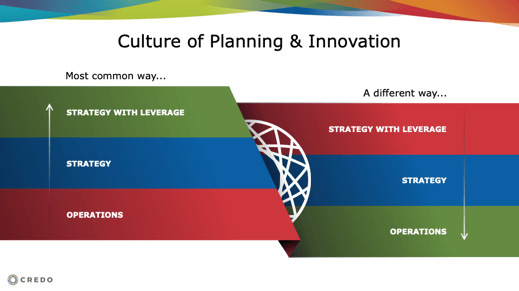
December 26 2018
The news sure looks bad: rapidly shifting student demographics, the ever-increasing speed of technological innovation, and extreme legislative and public pressure are squeezing colleges and universities into a lose-lose race toward irrelevancy. Detailed in countless articles and books, the challenges faced by institutions of higher learning in the U.S. are varied and weighty.
But higher education is far from doomed. It is at this inflection point in which independent colleges and universities have the opportunity to revolutionize higher education. It is time to pivot towards a new university, one that radically refocuses structure and pedagogy on students and their learning; reimagines the foundational institutional structures of leadership, tenure, and the higher education business model; and produces national examples for access and inclusion. In an industry notoriously slow to adapt and evolve, leaders of colleges and universities must act quickly and decisively, committing to a monumental shift to educate students for a world that we cannot yet see: a leap-frog into relevancy that higher education has never experienced.
Authors Joanne Soliday and Dr. Mark Lombardi, with their combined decades in higher education leadership and consulting, explicate a picture of possibility for the future of independent colleges and universities, one rooted in the essential value of a liberal arts education that brings students to their highest potential. It is the critical reimagining of how that education is shaped that guides a vision for the new university.
Join us for this blog series, based on the brand new, ground-breaking book Pivot: A Vision for the New University. We will explore what it means to pivot, how to strive towards becoming a "new university," and uncover the stories of four institutions who have successfully completed a pivot, unpacking what it has meant for their students, faculty/staff, administration, finances, and physical plant.
-
Defining a Pivot
As we explored our need to write a book and blog series, the concept of pivoting arose: a need to turn from some aspects of the culture of the institutions we had long known to the needs of the future. Once we began to say the word out loud to others, we heard many interpretations of what a pivot could mean in a college or university. A “pivot” is defined as a fixed point supporting something which turns or balances, or a person or thing on which something else depends. The powerful combination of these two definitions is exactly where we see institutions living out a pivot: finding the right points on which to change direction, with the success of the institution and its students depending upon that change.
A pivot does not look the same at all institutions. A pivot can be spurred by an external event; driven by a particular leader’s vision for what an institution can become; unearthed by a grassroots shift in institutional culture and thinking; or come in response to student, community, or regional needs. Regardless of the origin or shape, the pivot drives action relentlessly. It requires a determined effort to ask the question why at all levels. Why do we do things this way? Why do we allow long-standing traditions of the academy to become obstacles to the opportunities that we now have for how we examine and approach learning? Pivoting means that we actually ask these questions and many more, explicitly, and then act to address them. It means not settling for a process or a curriculum or an experience that does not clearly have students at the center. It means turning all the way around to a new way of thinking and doing so with a spirit of risk and hope.
Pivoting also implies a new approach to change. We used to believe that an institution must focus first on operations, build to strategy, and then approach strategy with leverage in order to achieve significant change, but the urgency for change in so many institutions today often makes that linear and incremental approach irrelevant. We are now seeing more and more examples of institutions that approach strategy with leverage—with a pivot—and recreate the rest of the organization around it, with operations and mid-level strategy responding to the demands of the pivot.
Pivoting gives higher education leaders and their institutions the opportunity to leapfrog over small, incremental steps, making the most important events happen quickly for the good of the students, campus, and community.

Which approach is your institution taking to planning and innovation? Find out how to make your own pivot, leapfrogging over small changes and achieving greater results faster.
-
© Credo and www.credohighered.com, 2018. Unauthorized use and/or duplication of this material without express and written permission from this site’s author and/or owner is strictly prohibited. Short excerpts and links may be used, provided that full and clear credit is given to Credo, Credo Press, and www.credohighered.com with appropriate and specific direction to the original content. Please email info@credohighered.com for information on how to obtain a full copy of Pivot: A Vision for the New University or for permission to use excerpts from the book and/or blog series.
Related Blog Posts
Recent Posts
- Richard Dunsworth, J.D., To Receive 12th Annual Courageous Leadership Award December 16 2024
- Meet the 2024 Credo Values Award Recipients August 27 2024
- What is Executive Coaching, Really? June 25 2024
- Credo & The Constructive Dialogue Institute Announce A New Partnership For Higher Education Leadership Development March 7 2024
- Celebrating Women And Gender-Diverse Learners & Leaders February 28 2024
Categories
- Strategy
- Leadership
- Student Success
- Student Success & Retention
- Enrollment
- Pivot
- Strategic Planning
- Leadership Development
- News
- Strategic Enrollment
- Campus Planning and Architecture
- Moving the Needle
- Data
- Research
- Retention
- Campus Master Planning
- Enrollment & Financial Aid
- Academic Programming
- Campus Planning
- Thriving
- Admitted Student Research
- Architecture
- Finance
- Advising
- Admissions




